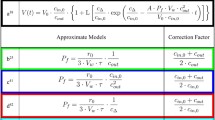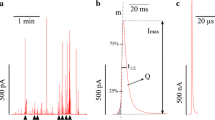Summary
Volume-dependent changes in light scatter have been shown to be a linear function of the osmotic gradient imposed upon gastric vesicles purified from hog gastric mucosa. Observation of the light scattered 90° to incident, using the Durrum stop flow system D-110, indicates that the vesicles exposed to hypertonic medium undergo rapid shrinkage due to water loss from the vesicle interior. The rate constant for this water movement is 1.1±0.09 sec−1 (n=10) and is linearly dependent on temperature between 16 and 36°C. The activation energy of 13.93±0.60 kcal mole−1 (n=3), calculated from an Arrhenius plot, is inconsistent with water movement facilitated by a large-pore aqueous channel. A slower reswell phase, dependent on solute entry into the intravesicular space, follows the water-dependent shrink phase. KCl entry, studied because of the intravesicular requirement for active K+/H+ transport, exhibits two entry stages. The faster, described by a single exponential imposed upon a constantly sloping background, has a rate constant of 7.75±0.48×10−3 sec−1 (n=15). The slower phase, which typically accounts for 90% of the reswell process, demonstrates a rate constant of 1.94±0.23×10−4 sec−1 (n=15). In the presence of valinomycin or nigericin, two fast rate constants and one slow rate constant of swelling are observed. The rate constant of the faster reswell phase is increased from 7.75±0.48×10−3 sec−1 (n=15) to 15.74±3.7×10−3 sec−1 (n=5) and 17.23±3.4×10−3 (n=3) by the addition of nigericin (1 μg ml−1) and valinomycin (4.5 μm), respectively. The second part of the faster reswell phase is approximately that seen in the control population. Transport-dependent volume changes of significant magnitude can be demonstrated following the addition of ATP to vesicles equilibrated with 150mm KCl. The volume change is a function of HCl leak rate and is abolished by ionophores which eliminate the transport-dependent pH gradient. So −-4 substitution, which eliminates the overshoot phenomena observed in KCl medium, also eliminates the shrinkage resulting from ATP addition.
Similar content being viewed by others
References
AL-Zahid, G., Schafer, J.A., Troutman, S.L., Andreoli, T.E. 1977. Effect of antidiuretic hormone on water and solute permeation, and the activation energies for these processes in mammalian cortical collecting tubules.J. Membrane Biol. 31:103
Bangham, A.D., DeGier, J., Greville, G.P. 1967. Osmotic properties and water permeability of phospholipid liquid crystals.Chem. Phys. Lipids 1:225
Chang, H., Saccomani, G., Rabon, E., Schackmann, R., Sachs, G. 1977. Proton transport by gastric membrane vesicles.Biochim. Biophys. Acta 464:313
Durbin R.P., Helander, H.F. 1978. Distribution of osmotic flow in stomach and gallbladder.Biochim. Biophys. Acta 179
Ganser, A., Forte, J. 1973. Ionophoretic stimulation of K+-ATPase of oxyntic cell microsomes.Biochem. Biophys. Res. Commun. 54:690
Hays, R., Leaf, A. 1962. The state of water in isolated toad bladder in the presence and absence of vasopressin.J. Gen. Physiol. 45:933
Hopfer, U., Nelson, K., Perrotto, J., Isselbacher, K. 1973. Glucose transport in isolated brush border membranes from rat small intestine.J. Biol. Chem. 248:25
Jacobs, M.M., Glassman, H.N., Parpart, A.K. 1935–36. Osmotic properties of the erythrocyte.J. Cell. Comp. Physiol. 7:197
Kamino, K., Inoue, A. 1969. Light-scattering studies on rabbit brain microsomes.Biochim. Biophys. Acta 183:36
Kinne, R., Murer, H., Kinne-Saffran, E., Thees, M., Sachs, G. 1975. Sugar transport by renal plasma membrane vesicles.J. Membrane Biol. 21:375
Kometani, T., Kasa, M. 1978. Ionic permeability of sarcoplasmic reticulum vesicles measured by light scattering method.J. Membrane Biol. 41:295
Lowry, O.H., Rosebrough, N.J., Farr, A.L., Randall, R.J. 1951. Protein measurement with the folin phenol reagent.J. Biol. Chem. 193:265
Nevis, A. 1958. Water transport in invertebrate peripheral nerve fibers.J. Gen. Physiol. 41:927
Owen, J.D., Eyring, E.M. 1975. Reflection coefficients of permeant molecules in human red cell suspensions.J. Gen. Physiol. 66:251
Price, H.D., Thompson, T.E. 1969. Properties of lipid bilayer membranes separating two aqueous phases: temperature dependence of water permeability.J. Mol. Biol. 41:443
Rabon, E., Chang, H.H., Saccomani, G., Sachs, G. 1978a. Transport parameters of gastric vesicles.Acta Physiol. Scand. Suppl., p. 409
Rabon, E., Chang, H., Sachs, G. 1978b. Quantitation of hydrogen ion and potential gradients in gastric plasma membrane vesicles.Biochemistry 17:3345
Rabon, E., Kajdos, I., Sachs, G. 1979. Induction of a chloride conductance in gastric vesicles by limited trypsin or chymotrypsin digestion or ageing.Biochim. Biophys. Acta (in press)
Saccomani, G., Crago, S., Mihas, A., Dailey, D., and Sachs, G. 1978. Tissue and cell localization of hog gastric plasma membranes by antibody techniques.Acta Physiol. Scand. Suppl. p. 293
Sachs, G. 1977. H+ transport by a non-electrogenic gastric ATPase as a model for acid secretion.Rev. Physiol. Biochem. Pharmacol. 79:133
Sachs, G., Chang, H., Rabon, E., Schackmann, R., Lewin, M., Saccomani, G. 1976. A non-electrogenic H+ pump in plasma membranes of hog stomach.J. Biol. Chem. 251:7690
Sachs, G., Chang, H., Rabon, E., Schackmann, R., Sarau, H.M., Saccomani, G. 1977. Metabolic and membrane aspects of gastric H+ transport.Gastroenterology 73:931
Sachs, G., Lewin, M., Spenney, J.G. 1978.Physiol. Rev. 58:106
Sachs, G., Rabon, E., and Saccomani, G. 1979. Active and passive ion transport by gastric vesicles.In: Cation Flux across Biomembranes, Y. Mukohata, L. Packer, editors. pp. 53–66. Academic Press, New York
Schackmann, R. 1976. Ph. D. Dissertation. Rice University, Houston
Schackmann, R., Schwartz, A., Saccomani, G., Sachs, G. 1977. Cation transport by gastric H+:K+ ATPase.J. Membrane Biol. 32:361
Sha'afi, R.I., Gary-Bobo, C.M., Solomon, A.K. 1971. Permeability of red cell membranes to small hydrophilic and lipophilic solutes.J. Gen. Physiol. 58:238
Tedeschi, H., Harris, D.L. 1955. The osmotic behavior and permeability to non-electrolytes of mitochondria.Arch. Biochem. Biophys. 58:52
Yoda, A., Hokin, L.E. 1970. On the reversibility of binding of cardiotonic steroids to a partially purified (Na++K+) activated adenosine triphosphatase from beef brain.Biochem. Biophys. Res. Commun. 40:880
Author information
Authors and Affiliations
Rights and permissions
About this article
Cite this article
Rabon, E., Takeguchi, N. & Sachs, G. Water and salt permeability of gastric vesicles. J. Membrain Biol. 53, 109–117 (1980). https://doi.org/10.1007/BF01870579
Received:
Revised:
Issue Date:
DOI: https://doi.org/10.1007/BF01870579




